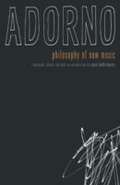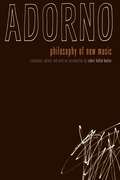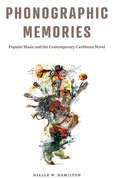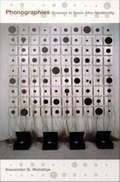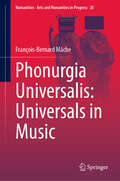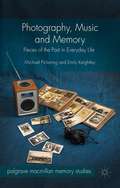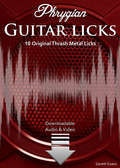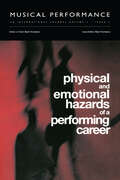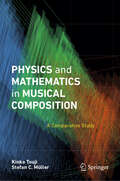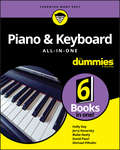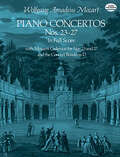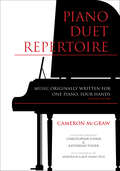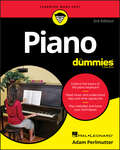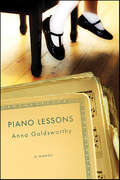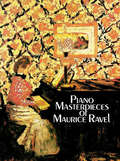- Table View
- List View
Philosophy of New Music
by Theodor W. Adorno Robert Hullot-KentorIn 1947 Theodor Adorno, one of the seminal European philosophers of the postwar years, announced his return after exile in the United States to a devastated Europe by writing Philosophy of New Music. Every aspect of this work was met with extreme reactions, from stark dismissal to outrage. Despite the controversy, Philosophy of New Music became highly regarded and widely read among musicians, scholars, and social philosophers.
Philosophy of New Music
by Theodor W. AdornoAn indispensable key to Adorno&’s influential oeuvre—now in paperbackIn 1949, Theodor W. Adorno&’s Philosophy of New Music was published, coinciding with the prominent philosopher&’s return to a devastated Europe after his exile in the United States. Intensely polemical from its first publication, every aspect of this work was met with extreme reactions, from stark dismissal to outrage. Even Arnold Schoenberg reviled it. Despite the controversy, Philosophy of New Music became highly regarded and widely read among musicians, scholars, and social philosophers. Marking a major turning point in his musicological philosophy, Adorno located a critique of musical reproduction as internal to composition, rather than a matter of musical performance. Consisting of two distinct essays, &“Schoenberg and Progress&” and &“Stravinsky and Reaction,&” Philosophy of New Music poses the musical extremes in which Adorno perceived the struggle for the cultural future of Europe: between human emancipation and barbarism, between the compositional techniques and achievements of Schoenberg and Stravinsky. In this translation, which is accompanied by an extensive introduction by distinguished translator Robert Hullot-Kentor, Philosophy of New Music emerges as an essential guide to the whole of Adorno's oeuvre.
Phish: The Biography
by Parke PuterbaughDrawing upon nearly fifteen years of exclusive interviews with the members of Phish, veteran music journalist Parke Puterbaugh examines the colorful chemistry that inspired the wildly popular rock group to push their four-man experiment to the limit. An intimate and fascinating portrait,Phish: The Biographyis the definitive story of these Vermont jam-band legends.
Phonographic Encounters: Mapping Transnational Cultures of Sound, 1890-1945
by Elodie A. Roy Eva Moreda RodríguezThis cross-disciplinary volume illuminates the history of early phonography from a transnational perspective, recovering the myriad sites, knowledge practices, identities and discourses which dynamically shaped early recording cultures. With case studies from China, Australia, the United States, Latin America, Russia, Sweden, Germany, Spain, Portugal, France, and Italy, Phonographic Encounters explores moments of interaction and encounter, as well as tensions, between local and global understandings of recording technologies. Drawing on an array of archival sources often previously unavailable in English, it moves beyond western-centric narratives of early phonography and beyond the strict confines of the recording industry. Contributions from media history, musicology, popular music studies, cultural studies, area studies and the history of science and technology make this book a key and innovative resource for understanding early phonography against the backdrop of colonial and global power relations.
Phonographic Memories: Popular Music and the Contemporary Caribbean Novel (Critical Caribbean Studies)
by Njelle W. HamiltonPhonographic Memories is the first book to perform a sustained analysis of the narrative and thematic influence of Caribbean popular music on the Caribbean novel. Tracing a region-wide attention to the deep connections between music and memory in the work of Lawrence Scott, Oscar Hijuelos, Colin Channer, Daniel Maximin, and Ramabai Espinet, Njelle Hamilton tunes in to each novel’s soundtrack while considering the broader listening cultures that sustain collective memory and situate Caribbean subjects in specific localities. These “musical fictions” depict Caribbean people turning to calypso, bolero, reggae, gwoka, and dub to record, retrieve, and replay personal and cultural memories. Offering a fresh perspective on musical nationalism and nostalgic memory in the era of globalization, Phonographic Memories affirms the continued importance of Caribbean music in providing contemporary novelists ethical narrative models for sounding marginalized memories and voices. Njelle W. Hamilton's Spotify playlist to accompany Phonographic Memories: https://spoti.fi/2tCQRm8
Phonographies: Grooves in Sonic Afro-Modernity
by Alexander G. WeheliyePhonographies explores the numerous links and relays between twentieth-century black cultural production and sound technologies from the phonograph to the Walkman. Highlighting how black authors, filmmakers, and musicians have actively engaged with recorded sound in their work, Alexander G. Weheliye contends that the interplay between sound technologies and black music and speech enabled the emergence of modern black culture, of what he terms "sonic Afro-modernity. " He shows that by separating music and speech from their human sources, sound-recording technologies beginning with the phonograph generated new modes of thinking, being, and becoming. Black artists used these new possibilities to revamp key notions of modernity--among these, ideas of subjectivity, temporality, and community. Phonographies is a powerful argument that sound technologies are integral to black culture, which is, in turn, fundamental to Western modernity. Weheliye surveys literature, film, and music to focus on engagements with recorded sound. He offers substantial new readings of canonical texts by W. E. B. Du Bois and Ralph Ellison, establishing dialogues between these writers and popular music and film ranging from Louis Armstrong's voice to DJ mixing techniques to Darnell Martin's 1994 movie I Like It Like That. Looking at how questions of diasporic belonging are articulated in contemporary black musical practices, Weheliye analyzes three contemporary Afro-diasporic musical acts: the Haitian and African American rap group the Fugees, the Afro- and Italian-German rap collective Advanced Chemistry, and black British artist Tricky and his partner Martina. Phonographies imagines the African diaspora as a virtual sounding space, one that is marked, in the twentieth century and twenty-first, by the circulation of culture via technological reproductions--records and tapes, dubbing and mixing, and more.
Phonurgia Universalis: Universals in Music (Numanities - Arts and Humanities in Progress #28)
by François-Bernard MâcheThis translation of Musique au singulier (2001) from the French identifies what is common to music of all times and cultures. The author, François-Bernard Mâche is a composer and internationally renowned musicologist. He addresses the question of universals in music and demonstrates how musical play is a poetic and natural game that already takes shape in the animal world. Mâche invites the reader to reconsider the traditional opposition between nature and culture and to reflect on experiencing such intense emotions when both listening to and manipulating sounds. This title appeals to students and researchers working in musicology.
Photography, Music and Memory: Pieces of the Past in Everyday Life (Palgrave Macmillan Memory Studies)
by Michael Pickering Emily KeightleyThis book explores how photography and recorded music act as vehicles or catalysts in processes of remembering, and how they are regarded, treated, valued and drawn upon as resources connecting past and present in everyday life. It does so via two key concepts: vernacular memory and the mnemonic imagination.
Phrygian Guitar Licks: 10 Original Thrash Metal Licks with Audio & Video (Modal Guitar Licks #3)
by Gareth Evans10 original thrash metal guitar licks from the Phrygian mode in tablature and notation for the progressing guitarist at intermediate level and above. >> 64 bars of music over 10 licks (average lick length 6.4 bars) >> Video at full speed & Audio at full & half speed (Downloadable) >> Backing tracks at full and slower practise speeds (Downloadable) >> Scale diagrams with theory and technique tips for each lick >> Guitar tablature has picking directions & fretting finger guide numbers Please Note: This eBook has written music and is not suitable for smaller screens.
Physical and Emotional Hazards of a Performing Career: A special issue of the journal Musical Performance.
by Basil TschaikovFirst Published in 2001. Routledge is an imprint of Taylor & Francis, an informa company.
Physics and Mathematics in Musical Composition: A Comparative Study
by Stefan C. Müller Kinko TsujiHow is music born? Is music made by humans or does it already exist and wait to be found? How do composers create (or find) music? Having these questions in mind the authors ask more questions: How can we share our feelings with other people when listening to music? Can these be visualized? Why did Helmholtz have a problem with the third? Why is precise tuning so important in European music and less so in other cultures? What are the differences among the continents? What makes dissonant tone intervals uncomfortable in many cases? What enables us to distinguish the music of Mozart from that of Beethoven? Why are we fascinated by birdsong? Why does some music survive, whereas other just disappears? And finally, along which lines will music develop in the future? Drawing upon physics and mathematics, the authors search for answers to these questions and attempt to unravel in some depth the enigmas of how our minds are affected by the perception of music.
Physics and Music: The Science of Musical Sound (Dover Books on Physics)
by Donald H. White Harvey E. WhiteThis foundational text is written for students who want to go beyond the perceptual stage of music to learn how musical sound is created and perceived. It surveys a wide range of topics related to acoustics, beginning with a brief history of the art and science of music. Succeeding chapters explore the general principles of sound, musical scales, the primary ways in which sound can be generated, the characteristics of instruments, the use of mechanical and electronic recording devices, hi-fi stereophonic and quadraphonic sound, the design of electronic musical instruments, and architectural acoustics.Comprehensive yet accessible, Physics and Music includes over 300 diagrams, photographs, and tables. Each chapter concludes with questions, problems, and projects, in addition to references for further study. 1980 edition.
Pianist's Progress
by Helen Drees RuttencutterIn Pianist's Progress, Helen Ruttencutter takes the reader behind the scenes in the fiercely competitive music world, vividly depicting a young musician's quest for a career. But ultimately her subject is the dynamics of training and grooming for success.
Piano & Keyboard All-in-One For Dummies
by Michael Pilhofer Holly Day David Pearl Blake Neely Jerry KovarskyYour complete guide to playing the keys Making beautiful music on a keyboard or piano requires some know-how and practice. This book offers guidance on how to get the most out of your time learning to play the keys. With six hands-on books wrapped up in one, you'll get a deep guide to the techniques the pros use. Discover the details of music theory and reading music, explore different musical genres, and use practice exercises to improve quickly. You'll even find tips on using electronic keyboard technology to enhance your sound. Inside… Piano & Keyboard 101 Understanding Theory and the Language of Music Beginning to Play Refining Your Technique and Exploring Styles Exercises: Practice, Practice, Practice Exploring Electronic Keyboard Technology
Piano Concertos: Nos. 23-27 in Full Score
by Wolfgang Amadeus MozartThis volume contains Mozart's last five piano concertos: No. 23 in A Major, K488; No. 24 in C Minor, K491; No. 25 in C Major, K503; No. 26 in D Major, K537; and No. 27 in B-flat Major, K595. As a bonus in the piano-plus-orchestra genre, the brief Concert Rondo in D Major, K382, has been added along with Mozart's own cadenzas for Nos. 23 and 27.The music is photographically reprinted from the Breitkopf & Härtel text, still considered the standard, authoritative edition for the Mozart concertos. Noteheads in this edition are large enough to be read easily, and margins and spaces between staves permit written notes, harmonic analysis, fingerings, and running measure numbers.Since Mozart's piano concertos are frequently performed in concert and there are several recordings currently available for each of these pieces, this edition is extremely useful for study, reference, and enjoyment.
Piano Duet Repertoire: Music Originally Written for One Piano, Four Hands (Indiana Repertoire Guides)
by Cameron McGrawSince the 1981 publication of the first edition, Cameron McGraw's Piano Duet Repertoire has been a trusted guide for duet performers. This second edition, edited and substantially expanded by Christopher and Katherine Fisher, brings the volume into the 21st century, adding over 500 new or updated composer entries and nearly 1,000 new work entries to the volume, a testament to the renewed interest in piano duet playing. Entries are arranged alphabetically by composer and include both pedagogical and concert repertoire. The annotations and the grade-level indications provide piano teachers a wealth of instructional guidance. The book also contains updated appendices listing collections and duet works with voice and other instruments. This new edition features a title index and a list of composers by nationality, making it a convenient and indispensable resource.
Piano Exercises For Dummies
by David PearlThe ideal hands-on reference for piano students who want to strengthen their skills and refine their technique--and the perfect companion and next step to the bestselling Piano For Dummies.Note: CD-ROM/DVD and other supplementary materials are not included as part of eBook file.
Piano Exercises For Dummies
by David PearlPractice, practice, practice to play like Chopin or the Piano Man The piano will help you add a touch of fun to your life, impress your friends at parties, and even reduce stress. It even makes you better at math (really!). Piano Exercises For Dummies is at your service as you learn to make those 88 black and white keys sing. You’ll get a quick overview of the basics before diving into practice routines and sample songs that you can use to improve your skill, whatever your level. This book gives you online access to audio files of the exercises along with digital access to the sheet music shared in the book. Learn from an experienced pianist, composer, and arranger, and start making beautiful music, the Dummies way! Refresh your knowledge of the piano basics so you’re poised and prepared to play the right way Play enjoyable practice exercises and songs designed to teach specific skills and techniques in all genres Go online to access all the audio files, anytime, anywhere Bring a little more joy into your life by stepping up your piano know-how Piano Exercises For Dummies is for new and experienced pianists alike, and useful for improving your skill in any musical style.
Piano For Dummies
by Adam Perlmutter Hal Leonard Corp.Play the piano today with an easy-to-use instruction set!Piano For Dummies, 3rd Edition is an invaluable resource for anyone seeking fundamental piano instruction. Whether you're brand new to the piano or have been at it awhile, Piano For Dummies will soon have you tickling the ivories like a pro! This book contains all the information you need to start playing today, including clear instruction and supplementary materials. Learn different musical styles, like classical, rock, blues, and country, and how to find the perfect teacher should you decide to expand your instruction.With the widest tonal range of any instrument, the piano is versatile enough to produce melody and accompaniment at the same time. This standout feature is also what makes mastering the piano such a complex affair. Piano For Dummies, 3rd Edition breaks it down into simple, easy-to-follow instruction, written in the characteristically accessible Dummies style. For the beginner, the book serves as a complete introductory course. For the more advanced player, it becomes a handy reference to keep around for periodic refreshers. Topics include:Finding the perfect keyboard, and caring for your pianoThe intricacies of reading music, including notes, rhythm, and change-upsMelody, harmony, and the building blocks of soundThe role of individual technique, and finding your own grooveThe book also includes advice on practicing efficiently and improving your performance, as well as tips on how to pursue more advanced experiences. A great piano player is always the life of the party, and in high demand. If you're looking to become one with the "88," Piano For Dummies, 3rd Edition is the resource you want!
Piano For Dummies
by Blake NeelyThe long-awaited update to the bestselling Piano For Dummies-featuring a new audio CDHave you always wanted to play piano? This revised edition of the popular Piano for Dummies makes it easier and more fun than ever. If you don't know how to read music, this book explains in friendly, uncomplicated language all the basics of music theory and applies it to playing the piano. And if you've been playing piano for a while - or took piano lessons when you were a child but haven't played since - you can pick up some valuable tips to improve your playing or use the book as a refresher course.This new edition features fresh and updated practice lessons, teaching techniques, and musical examples, as well as a new audio CD with examples for all pieces presented in the book. You get expert information on left- and right-hand piano techniques; playing scales, melodies, harmonies, and chords; and practicing to improve your technique.Everything you need to start playing piano todayPlenty of popular musical pieces and songs, with companion audio CD to play along withInstruction in playing various musical styles, from classical and rock to blues and countryBlake Neely is an Emmy-nominated composer and accomplished pianist who has composed numerous TV and movie scoresIf you've always wanted to tickle the ivories like a pro, Piano For Dummies, 2nd Edition is your ideal resource!Note: CD-ROM/DVD and other supplementary materials are not included as part of eBook file.
Piano For Dummies, 3rd Edition: The Fun And Easy Way To Start Playing Your Favorite Songs Today!
by Hal Leonard CorporationExplore the basics of the piano keyboard Read music and understand keys and time signatures Play melodies and hone your techniques If you've dreamed of playing piano, here's where to start! There's no better way to start learning music than by learning how to play piano. It doesn't matter if you've never had a lesson or need a refresher on piano basics, this book helps you discover the joy of making music on the most versatile instrument of all. Simple step-by-step instruction gets you started, guiding you from basic beginner tunes into more advanced techniques. Get acquainted, or reacquainted, with how to read music, play chords, and build your own playing style. Inside... Play your first notes Find Middle C and beyond Get started with beginner tunes Approach old lessons in a new way Navigate sharps and flats Learn more with online audio and video
Piano Lessons: A Memoir
by Anna GoldsworthyAnna Goldsworthy was nine years old when she met Eleanora Sivan, the charismatic Russian émigré and world-class pianist who became her piano teacher. Piano Lessons is the story of what Mrs. Sivan brought to Anna's lessons: a love of music, a respect for life, a generous spirit, and the courage to embrace a musical life.Beautifully written and strikingly honest, Piano Lessons takes the reader on a journey into the heart and meaning of music. As Anna discovers passion and ambition, confronts doubt and disappointment, and learns about much more than tone and technique, Mrs. Sivan's wisdom guides her:"We are not teaching piano playing. We are teaching philosophy and life and music digested." "What is intuition? Knowledge that has come inside.""My darling, we must sit and work."Piano Lessons reminds us all how an extraordinary teacher can change a life completely. A work that will appeal to all music lovers and anyone who has ever taken a music lesson, Piano Lessons will also touch the heart of anyone who has ever loved a teacher.
Piano Masterpieces of Maurice Ravel (Dover Music for Piano)
by Maurice Ravel"Ravel is one of the rare French composers who have left so strong an imprint on their art that music after them can never be the same." -- Alexis Roland-Manuel. Maurice Ravel (1875-1937) ranks as one of the most original French composers of his time, a consummate craftsman who continually sought perfection of form and style, and whose unique harmonic language was unmistakably his own. Along with Debussy, he stands in the front rank of great modern composers for the piano and his piano music includes a number of masterpieces considered vital to the repertoire of any serious pianist. This handsome, affordable volume reprints a rich selection of his compositions: "Pavane pour une infante défunte," "Jeux d'eau," "Sonatine," "Miroirs," "Menuet antique," "Menuet sur le nom d'Haydn," "Gaspard de la nuit," and more.From the dazzling "Jeux d'eau," whose inventiveness and harmonic ingenuity opened a whole new era in sound, to the beloved "Pavane pour une infante défunte," to the suite "Gaspard de la nuit," music of legendary difficulty that every serious pianist eventually attempts, the piano music of Ravel is among the most recorded and performed in the repertoire. This inexpensive Dover edition makes that music available, at a reasonable price, to pianists who wish to play and study the works of a composer in the vanguard of "the new order of post-Lisztian piano writing."
Piano Music for Little Fingers: Book 2 (Dover Classical Piano Music For Beginners)
by Ann Patrick GreenThe third volume in this series for pianists ages 4 to 9, this book contains more songs in the already familiar key of G. New topics include the key of F and extended hand positions with six-note melodies, plus the IV chord in all keys, dotted rhythms, dynamics, staccato and legato touches, and two-note and longer phrases. Heartwarming Family Circus cartoons appear throughout the book."Of all the piano instruction books and courses out there, yours is the best by far, because it combines theory, fun, a wonderful variety of songs, and of course, the 5-point learning plan. Thank you for providing such a fantastic piano course for children!" -- Beverly Short, Santa Monica, California"You've really found a wonderful way of making music fun for children with your songs. The songs are infused with spirit, so it makes learning truly enjoyable for students." -- Monica Le, Fullerton, California"I love these books because they work! I have been using them for many years with children 4 years old and up. The big notes make note learning easy and the directions for teachers are clear and methodical. My students and their parents are excited as they graduate from one level to the next. These books truly teach little fingers to play! Thank you, Ann Patrick Green!" -- Carol Orozco, Fullerton, California"I use Ann Patrick Green's books with every student. The larger note size, the use of solfege note reading, the inclusion of theory and the way each book is organized makes teaching and learning easy and fun." -- Lisa Smith, piano teacher
Piano Music for Little Fingers: Book 2 (Dover Classical Piano Music For Beginners)
by Ann Patrick GreenThe third volume in this series for pianists ages 4 to 9, this book contains more songs in the already familiar key of G. New topics include the key of F and extended hand positions with six-note melodies, plus the IV chord in all keys, dotted rhythms, dynamics, staccato and legato touches, and two-note and longer phrases. Heartwarming Family Circus cartoons appear throughout the book."Of all the piano instruction books and courses out there, yours is the best by far, because it combines theory, fun, a wonderful variety of songs, and of course, the 5-point learning plan. Thank you for providing such a fantastic piano course for children!" — Beverly Short, Santa Monica, California"You’ve really found a wonderful way of making music fun for children with your songs. The songs are infused with spirit, so it makes learning truly enjoyable for students." — Monica Le, Fullerton, California"I love these books because they work! I have been using them for many years with children 4 years old and up. The big notes make note learning easy and the directions for teachers are clear and methodical. My students and their parents are excited as they graduate from one level to the next. These books truly teach little fingers to play! Thank you, Ann Patrick Green!" — Carol Orozco, Fullerton, California"I use Ann Patrick Green's books with every student. The larger note size, the use of solfege note reading, the inclusion of theory and the way each book is organized makes teaching and learning easy and fun." — Lisa Smith, piano teacher
